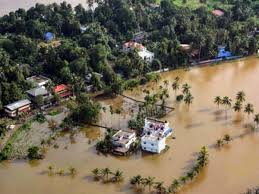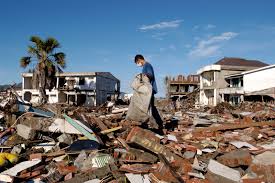WHAT IS DISASTER- MEANING & TYPES
INTRODUCTION
Disaster is a serious disruption of the functioning of a community or society, which involves widespread destruction of life and property or environmental loss, which exceeds the ability of the affected community or society to cope using its own resources.
According to WHO (World Health Organization), A disaster is an occurrence disrupting the normal conditions of existence and causing a level of suffering that exceeds the capacity of adjustment of the affected community.
Disaster may be natural or man-made event, however, it is the people who matter most, and without the people we have no disaster.
SOME IMPORTANT DEFINITION
Emergency– A states in which normal procedures are suspended and extra-ordinary measures are taken in order to avert a disaster.
Hazard– A natural or human-made event that threatens to adversely affects human life, property or activity to the extent of causing a disaster.
Vulnerability– the predisposition to suffer damage due to external events.
Susceptibility– exposure to danger.
Resilience – adaptability, capacity to recover.
CLASSIFICATION– Disaster is generally categorized under two heads.
- Natural Disaster– A natural disaster is such event which occurs naturally and may case loss of life, injury or other health impacts, property damage, loss of livelihoods and services, social and economic disruption, or environmental damage. Examples are earthquakes, tsunami waves, landslides, volcanic eruptions, hurricane, cyclones, flood etc.
- Man-made Disaster– these are such events which occur mainly due to human activities. In fact, such events are the consequence of technological or human hazards. Examples are stampedes, fires, transport accidents, industrial accidents, oil spills, terrorist attacks, nuclear explosions/nuclear radiation. War and deliberate attacks may also be put in this category.
MEANING OF SOME DISASTER
Blizzard– A severe snowstorm is characterized by very strong winds and low temperatures. It causes lifting of snow from surface. Ground blizzard refers to a weather condition where loose snow or ice on the ground is lifted and blown by strong winds.
Earthquake– it is sudden shaking of the surface of the Earth resulting from a sudden release of energy in the Earth’s lithosphere that creates waves of energy that travels through the earth layer.
- The intensity of earthquake is measured on Richter scale from 0 to 9.
- Charles Richter had made a scale to study earthquake which is known as Richter scale.
- Earthquake of intensity lower than 5.4 on Richter scale is not hazardous.
- Earthquake of intensity above 7.0 is disastrous. Whereas 8.1 or more on Richter scale is catastrophic.
Flood– A flood is an overflow of water that submerges land. Flooding may occur due to heavy rains, overflow of water from water bodies, such as a river, lake, or oceans.
- In India, flood is more common and causes heavy loss almost every year.
- Deforestation is one of the reasons which increase the frequency and intensity of flood due to no obstruction in the path of water bodies.
- Flood streams washes off mud houses and huts, badly affects the roads, railways tracks, bridge, electric poles etc., damages standing crops, spoil the clean water, decomposition of organic materials spoil the environment and thus favors the spread of diseases.


Land slide– Landslides occur when the slope (or a portion of it) undergoes some processes that change its condition from stable to unstable. It refers to sudden downward movement of land or rocks due to gravitational forces in mountain and hilly areas. It is recurrent phenomenon in hilly areas. Though, rainfall or snowfall is major cause of landslide, but human activities like mining and deforestation are also responsible. It blocks the road and crushes everything comes under it. Communication system also gets destroy.
Tsunami– Tsunamis are giant waves caused by earthquakes or volcanic eruptions, which displace the large volume of water under the sea.
Cyclones/Typhoons/Hurricanes– A cyclone is a large scale air mass that rotates around a strong center of low atmospheric pressure. Cyclones are characterized by inward spiraling winds that rotate counter clockwise in northern hemisphere, while clockwise in the southern hemisphere of the earth.
- Cyclones are generally associated with high speed winds and heavy rainfall.
- It is more common in tropical regions because of high temperature and high humidity.
- Cyclones are called Typhoons in pacific oceans, china and japan, whereas it is called hurricane in North America. In north Atlantic and Indian Ocean, it is called cyclones.
Fire (wild) – Its negative effects include hazard to life and property, atmospheric pollution, and water contamination. Wild fire causes loss of forest, vegetation and many wild lives. It deteriorates the ecological balance and reduces biodiversity.
MAN MADE
- Nuclear/Radio-logical Disaster– It is an event that has led to significant consequences to people, the environment or the facility. Nuclear bomb had caused heavy loss in japan in 1945 during world war. The disaster destroyed all structure and life, contaminated all the resources too.
- Chemical and industrial accidents– Such accidents are occurred due to sudden release of chemicals due to technical fault, negligence or due to geological hazards. These accidents pollute air, water and land resources and disturb ecological balance. As a result several people die, injure and several health problems occur.
- Epidemic or Biological Hazards- the spread of infectious disease at large scale is called epidemic. It can be more disastrous than earthquake, tsunami, flood, cyclones etc. use of biological weapons can create epidemic and it can severely affect the countries where sanitation is not good and people live in slums.
- Mechanical Disaster- Due to any mechanical fault or driving error, such disaster occurs. Rail and vehicle accidents are the examples. Similarly aeroplanes are crashed due to engine faults.
Read more…
WHAT IS ECOLOGY- OVERVIEW & TYPES
ESSAY ON ENVIRONMENTAL POLLUTION
WHAT BIODIVERSITY IS-MEANING,TYPES&THREATS
TYPES OF THE ECOSYSTEM
ENERGY FLOW OF ECOSYSTEM
CENTRAL POLLUTION CONTROL BOARD
WHAT IS EUTROPHICATION-MECHANISM, CONSEQUENCES & CONTROL